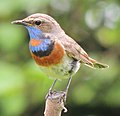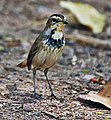Bluethroat
This article needs additional citations for verification. (March 2024) |
| Bluethroat | |
|---|---|

| |
| L. s. svecica, Oppdal, Norway | |
| Song recorded in Chukotka, Russia | |
| Scientific classification | |
| Domain: | Eukaryota |
| Kingdom: | Animalia |
| Phylum: | Chordata |
| Class: | Aves |
| Order: | Passeriformes |
| Family: | Muscicapidae |
| Genus: | Luscinia |
| Species: | L. svecica
|
| Binomial name | |
| Luscinia svecica | |

| |
| Distribution of the bluethroat (orange: breeding range; blue: non-breeding range) | |
| Synonyms | |
| |
The bluethroat (Luscinia svecica) is a small passerine bird that was formerly classed as a member of the thrush family Turdidae, but is now more generally considered to be an Old World flycatcher, Muscicapidae. It, and similar small European species, are often called chats.
It is a
The bluethroat bird is similar in size to the European robin at 13–14 cm. It is plain brown above except for the distinctive black tail with red side patches. It has a strong white supercilium. Despite the distinctive appearance of the males, recent genetic studies show only limited variation between the forms, and confirm that this is a single species.[2] Moults begins in July after breeding and are completed in 40–45 days, before the birds migrate.[3]
The male has a varied and very imitative song.[4] Its call is a typical chat chack noise.
Subspecies

See the Wikispecies page.
Females of all subspecies usually have just a blackish crescent on an otherwise cream throat and breast. Newly fledged juveniles are freckled and spotted dark brown above.
Etymology

The genus name Luscinia is
Gallery
-
Male (L. s. volgae), Elektrougli, Russia
-
Male (L. s. cyanecula), Biebrzaski, Poland
-
Red-spotted race
-
Eggs, CollectionMuseum Wiesbaden, Germany
-
KSA1992
References
- ^ BirdLife International (2012). "Cyanecula svecica". IUCN Red List of Threatened Species. 2012. Retrieved 14 October 2022.
- PMID 14629386. Archived from the original(PDF) on 2005-04-04.
- ISBN 978-1-4729-0647-2.
- ^ Metzmacher M. (2008) Les Grillons, muses de la Gorgebleue à miroir blanc (Luscinia svecica cyanecula) ? Parcs & Réserves, 63 : 17-19.
- ISBN 978-1-4081-2501-4.
External links
- Bluethroat videos, photos & sounds on the Internet Bird Collection
- Ageing and sexing (PDF; 3.4 MB) by Javier Blasco-Zumeta & Gerd-Michael Heinze
- Information and pictures about the Bluethroat in the Netherlands
- Metzmacher M. (2008) Les Grillons, muses de la Gorgebleue à miroir blanc (Luscinia svecica cyanecula) ? Parcs & Réserves, 63 : 17-19. (in French)







